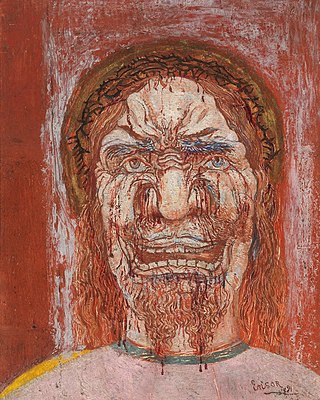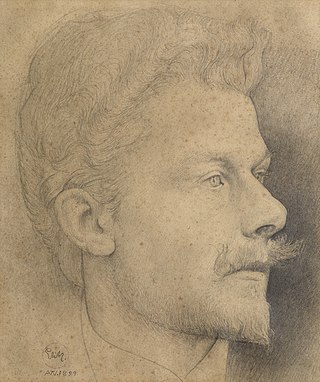
Édouard Manet was a French modernist painter. He was one of the first 19th-century artists to paint modern life, as well as a pivotal figure in the transition from Realism to Impressionism.

The Potato Eaters is an oil painting by Dutch artist Vincent van Gogh painted in April 1885 in Nuenen, Netherlands.

Théophile "Théo" van Rysselberghe was a Belgian neo-impressionist painter, who played a pivotal role in the European art scene at the turn of the twentieth century.

James Sidney Edouard, Baron Ensor was a Belgian painter and printmaker, an important influence on expressionism and surrealism who lived in Ostend for most of his life. He was associated with the artistic group Les XX.

John de Critz or John Decritz was one of a number of painters of Flemish origin active at the English royal court during the reigns of James I of England and Charles I of England. He held the post of Serjeant Painter to the king from 1603, at first jointly with Leonard Fryer and from 1610 jointly with Robert Peake the Elder.

Osias Beert or Osias Beert the Elder was a Flemish painter active in Antwerp who played an important role in the early development of flower and "breakfast"-type still lifes as independent genres in Northern European art. He has been recognized as one of the most influential artists of the earliest generation of still life painters in Flanders. He contributed in particular to the development of still lifes placed on table tops featuring festive culinary delights as well as of sumptuous floral bouquets, typically displayed in Wan Li vases.

Joos van Craesbeeck (c. 1605/06 – c. 1660) was a Flemish baker and a painter who played an important role in the development of Flemish genre painting in the mid-17th century through his tavern scenes and dissolute portraits. His genre scenes depict low-life figures as well as scenes of middle-class people. He created a few religiously themed compositions.

Rodolphe Paul Marie Wytsman was a Belgian Impressionist painter. He trained at the Académie Royale des Beaux-Arts in Brussels, and was one of the founding members of Les XX, a group of avant-garde Belgian artists.

Christ's Entry Into Brussels in 1889 is an 1888 painting by the Belgian artist James Ensor. The post-Impressionist work, parodying Jesus' triumphal entry into Jerusalem celebrated on Palm Sunday, is considered Ensor's most famous composition and a precursor to Expressionism. It has been held by the Getty Center in Los Angeles since 1987.

Ferdinand de Braekeleer, sometimes spelled as Ferdinand de Braeckeleer, was a Flemish painter and printmaker. He is known for his paintings of genre scenes, church interiors, historic events, religious scenes, cityscapes, market scenes and market still lifes. He is called 'the Elder' to distinguish him from his son with the same name, who was also a painter.

Frans Van Leemputten or Frans van Leemputten was a Belgian Realist painter who specialized in landscape paintings of the Campine and Brabantine regions in Belgium as well as scenes with villagers and animals.

Jan Stobbaerts or Jan-Baptist Stobbaerts was a Belgian painter and printmaker. He is known for his scenes with animals, landscapes, genre scenes and portraits or artists. With his dark-brown studio tones and forceful depiction of trivial subjects, Stobbaerts was a pioneer of Realism and 'autochthonous' Impressionism in Belgium.

De strijkster is a painting by Rik Wouters in the Royal Museum of Fine Arts Antwerp. It is one of many scenes from daily life from which the painter found inspiration and took as a subject. His wife, muse and favourite model was Hélène Duerinckx (Nel).

The Old Folks Sing, the Young Folks Chirp is a 1638–1640 oil-on-canvas painting by the Flemish artist Jacob Jordaens, now in the Royal Museum of Fine Arts Antwerp. He painted several works with this title, a Dutch proverb – this is the earliest of them, whilst another is now in Valenciennes.

The Intrigue is an oil-on-canvas painting created by Belgian expressionist painter James Ensor in 1890. This painting is in the possession of Royal Museum of Fine Arts Antwerp and is part of the official inventory of Flemish masterpieces. Ensor painted a second version in 1911, which is now in the Minneapolis Institute of Art.

The Rooftops of Ostend is an oil-on-canvas painting by the Flemish expressionist painter James Ensor. This painting is on the official inventory of Flemish masterpieces. The Rooftops of Ostend is in the possession of Royal Museum of Fine Arts Antwerp.

The Man of Sorrows is an 1891 oil painting by the Flemish expressionist painter James Ensor. This painting is enlisted on the official inventories of Flemish masterpieces and is a part of the great masters collection of the Royal Museum of Fine Arts Antwerp.

The Oyster Meal is an oil on canvas genre painting by the Dutch Golden Age artist Jacob Ochtervelt, dated to around 1664–65. It depicts a man offering a plate of oysters to a woman he is trying to seduce.

Jean-Baptiste Berré or Jan Baptist Berré Antwerp, 11 February 1777 – Paris, 6 May 1839) was a Flemish painter and sculptor. He trained in Antwerp where he painted mainly still lifes. He later moved to Paris where he made a name as an animalier painter and sculptor. His patrons included members of the court during the First French Empire and the First Restoration. He was employed as an official painter at the Jardin du Roi in Paris. In this role he was chosen as one of the artists invited to portray Sarah Baartman, the 'Hottentot Venus', in 1815.

Charles Mertens, Karel Jozef Mertens or Karel Mertens was a Belgian draughtsman, painter, muralist, etcher and illustrator. He is known for his portraits, landscapes and genre scenes. He painted many scenes with fishermen and fishing boats.



















